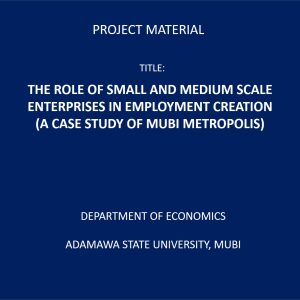No products in the cart.
Antibacterial Activity of Crude Ethanolic Extract of Vernonia Amygdalina Against Hemolysin Producing Uropathogens
₦10,150.00
ANTIBACTERIAL ACTIVITY OF CRUDE ETHANOLIC EXTRACT OF VERNONIA AMYGDALINA AGAINST HEMOLYSIN PRODUCING UROPATHOGENS
- PROJECT YEAR:2022T
- NUMBER OF PAGES: 42
- FILE TYPE: PDF
- DEGREE: BACHELOR
- DEPARTMENT: DEPARTMENT OF MICROBIOLOGY, FACULTY OF LIFE SCIENCES, MODIBBO ADAMA UNIVERSITY, YOLA,
ABSTRACT
The aim of this study was to determine the antibacterial activity of crude ethanolic extract of vernonia amygdalina against hemolysin producing uropathogens. 120 Urine samples were collected using clean catch method in a sterile urine container. The organisms were isolated on CLED media using streak plate method and were identified by their respective morphological characteristics, gram reaction and biochemical tests. A total of 102 isolates made up of 4 gram negative bacteria and 2 gram positive bacteria namely; Escherichia coli, Staphylococcus aureus, Klebsiella spp., Enterococcus spp., Enterobacter aerogenes and Pseudomonas aeruginosa were isolated in this study, with E. coli being the most predominant bacteria and Pseudomonas aeruginosa being the least bacteria isolated. Some of the isolates have hemolytic activity (some alpha hemolytic, beta hemolytic and gamma hemolytic), hemolytic activity aids in the pathogenesis and also contributes to the severity of the infection. The antibacterial activity of the crude ethanolic extract against the bacterial isolates was determined by spread plate using agar well diffusion method. The result showed that, the crude ethanolic extract of Vernonia amygdalina had no activity against the various bacterial isolates obtained at different concentrations. the lack of activity in this study might not only be attributed to hemolytic activities but also, the organism might have had a prior exposure to the plant, since it is common and locals use it for different purposes. There is a need to use a different solvent for the extraction to get enough quality and quantity of the bioactive molecules, public health awareness should be conducted to locals on the implication of abusive use of medicinal plants and the risk associated and measures to understand individual and population-specific risk factors associated with recurrent UTIs be put in place so as to help physicians tailor prophylactic strategies.


